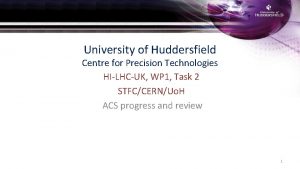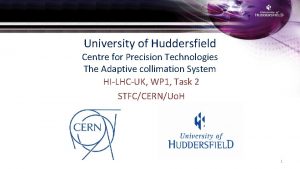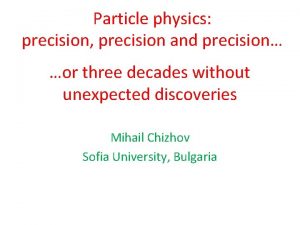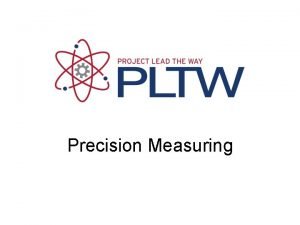University of Huddersfield Centre for Precision Technologies HILHCUK













- Slides: 13

University of Huddersfield Centre for Precision Technologies HI-LHC-UK, WP 1, Task 2 STFC/CERN/Uo. H Design and integration of an active dynamic compensation for the collimator jaw in the Multimat experiment Thomas Furness / Simon Fletcher 1

Context: Adaptive Collimation System (ACS) • Aim: to dynamically correct distortions in the collimator jaws, caused by inoperation events, namely thermal deformation. • Travel: ± 100µm in varying shapes • ACS to be incorporated upon TCSPM collimator design currently being tested here at CERN. • ACS consists of two areas of interest: ACS Actuation Measurement 2

ACS Measurement - SPM • Preliminary Sensor – slotted photo-mircosensor (SPM) • Attributes: – – High resolution (21 nm) Low cost Custom in CPT design High success rate with other projects. • Cons: – Not designed to withstand out gassing temperatures. – Increases installation difficulty – SPM susceptible to radiation damage. 3

ACS Measurement – DRI • Current Measurement Solution: DRI (Dispersed Reference Interferometry) Strain measurement 4

ACS Measurement - DRI • Current Measurement Solution: DRI Strain measurement – Attributes: Easy to install Versatile Fibres design to withstand high temperatures. Major components located outside of vacuum tank • Absolute measurement system • • – Cons: • Higher start up cost • Fibres susceptible to spectral absorption (darkening). • Bonding Issues 5

ACS Actuation • Potential actuation solutions: – Metal ceramic patches • Cheap, low risk, small power requirements • However, Long rise times. – Piezo Actuators High force generation Multiple options in the market. Extremely fast rise times. Displacement is inversely correlated to force generation. • Critical damage induced though high temps, over preloading, excess voltage, shock loading. • Require high voltages • • 6

ACS Actuation • Rise times Piezo Rise Times 0. 000000 0. 200000 0. 400000 0. 600000 Thermal Actuation Rise Times 0. 800000 1. 000000 1. 200000 180 -20. 000000 160 -40. 000000 140 -60. 000000 120 -80. 000000 100 -100. 000000 80 -120. 000000 60 -140. 000000 40 -160. 000000 20 -180. 000000 0 Disp Rise Time 0. 000072 [µm] Disp rise Time 0. 00072 [µm] Disp Rise Time 0. 0072 [µm] Disp rise Temp 0. 072 [µm] 0 5 Maximum Disp at 300 c [µm] 10 15 Maximum Disp at 400 c[µm] 20 25 Maximum Disp at 250 c [µm] Disp Rise Time 0. 72 [µm] 7

Multi-Mat @ CERN • What is Multi-Mat? – – – Material testing experiment 16 Stations for material samples To be assembled summer 2017 Installed into Hi. Rad. Mat In SPS At CERN Tested end of year 2017 Uo. H have been given 1 dedicated station for equipment testing 8

Multi-Mat Adaptive Collimation System V 3 (MMACS) • MMACS will allow us to test the measurement/actuation when in close proximity to the beam. Test Station 2 Beam Direction Test Piece Clamps Test Station 1 9

Multi-Mat Adaptive Collimation System (MMACS) Piezo Actuator Housing Fibre Tracks Beam Direction offset form centre of test 10

Multi-Mat Adaptive Collimation System (MMACS) Around 50 -60µm Piezo to induce reversing force Offset beam to induce thermal distortion 300 N Piezo force Direction Of movement 11

Multi-Mat Adaptive Collimation System (MMACS) What Next? • In depth beam simulations of Multi-Mat test rig. • Manufacture start in UK simulation pending • Drawings to be released end of Feb • Manufacture and assembly to be Completed mid April • ¼ size (NOT ¼ scale) model of collimator jaw to test actuation and measurement in full – design in progress • Start designs and simulations for final collimator design. 12

Centre for Precision Technologies Thank you Tom Furness, Simon Fletcher, Andrew Longstaff Email: t. furness@hud. ac. uk/thomas. furness@cern. ch
 Non-precision instruments are
Non-precision instruments are Difference between precision and semi precision attachments
Difference between precision and semi precision attachments Single precision vs double precision
Single precision vs double precision Alton cars barnsley
Alton cars barnsley Architectural design in huddersfield
Architectural design in huddersfield Keyword research huddersfield
Keyword research huddersfield Apa referencing huddersfield
Apa referencing huddersfield Castle hill school huddersfield
Castle hill school huddersfield Handelsbanken huddersfield
Handelsbanken huddersfield Ptc e learning
Ptc e learning Centroid statics
Centroid statics Center of gravity for different shapes
Center of gravity for different shapes Tashkent university of information technologies
Tashkent university of information technologies Mogilev state university
Mogilev state university

























